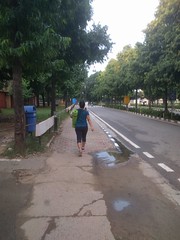Is this the Journey or Is the Destination for #India’s #Women?
Standing at the Chembur platform my two flat mates and I gravitate towards where all the other women are standing and assume that they know where the female car of the railway halts. Waiting for the train, we’re carefree, not anxious, not worried, but relaxed. This is partially because we are so excited to finally be in Mumbai, but primarily because we know that no men are pressing up against us in preparation for getting on the train and none await us with prying eyes and wandering hands in the packed train. Yes, we are relaxed and even as we are pushed and shoved into the slowly moving train, we’re still calm. Once we are in the women’s car our only concern is people watching and gazing out the open doors into the madness of Mumbai’s inner city.
After a few stops a transgender individual enters the car wearing a bright yellow sari and smiles to expose a set of missing front teeth. She proceeds to do a short dance and then touch us all on the head, perhaps to bless our woman-ness or supposed femininity but mainly to extract money from those amongst us who are superstitious of non-conformity. Cheerfully she makes her way through the car and eventually disappears into the male dominated general section of the train. She is the first person to call into the question the space we inhabit, this ‘female only’ car that relieves us and makes uscomfortable. So at ease is every body that a few women are lying on the floor, a set of women are gossiping, several in niqab have momentarily lifted their scarves to re-arrange themselves, a mother combs lice out of her daughters hair, and we glance around the car or out the window, taking in the raw sights and smells of one of India’s most populated cities. We let our minds wander, but we do not think about the static definitions we are conforming to in this diverse car, we do not question ourselves.

The placard reads: “I pledge that I will travel in all the train compartments, not just the ones reserved for women. I want the whole city to be safe for women. ~ A Safe City Pledge”
At the next stop, a boy drifts casually through the car, selling accessories while a woman heavily loaded with chili’s and lemons temporarily sets up shop in the corner. We gaze, but never for too long. We count the number of remaining stops, thinking how wonderful it is that there is a car ‘only’ for women. We notice a young lady texting furiously with a sly smile and wonder who she is chatting with. We watch her as she gets off the train at Cotton Green and notice that she unites with a young man who had been on the same train in another car. We find it cute, sweet even. At the time it does not occur to us that the general cars are so uncomfortable that a woman would not even enter one with her boyfriend. We hold onto the sticky handles and turn our attention to how convenient and reasonable the railway is for everyday commuters. We do not mind when women push up against us or eye us in judgment or curiosity. For us it is an experience.
When a same-sex couple enter the car and take their seats in front of us we’re thrilled to see them. We nod at each other and think ‘how progressive’ without considering what this implies within the car or perhaps what it may mean outside of this female only railway car. We try to keep track of all the different types of people we are seeing on our short trip. We inhale the sights, drink them in even. When the train runs parallel to another line we look at the general cars opposite us, packed so tightly with men that many hang out of the doors and gasp for air.
We feel lucky to be in the female car and almost panic at the idea of being in a car such as the ones we see. At that moment, we do not realize that our position is at once freeing and limiting. This car symbolizes empowerment and safety, but it also reiterates our social inability. We are so unable that we must be restricted to a single car, we remain so reduced by fear and experience that we begin to believe that this car in the train represents progression. Yet, it reminds us that the only artificial sense of safety is one free of men so we all continue to live the stereotypes and thus continue to reiterate them.
Throughout the trip, we are at once acutely conscious of the fact that this moment of comfort is temporary, in a sense it is false, and it is also quite unfair. It echoes all of the issues that circulate during conversations over chai, late night walks home, or when opening a newspaper. In other words, it gives women security, but the security provided conforms to the social norms that limit women in the first place. Therefore, we too are reinstating and participating in these problematic norms, partly because we may not have another choice.
 As we arrive at the next platform a solider in uniform holding his gun enters the car and secures himself a corner by the door. We all cringe at his sense of authority and his belief at being somehow above the categories that ‘define’ this car. He hisses and directs women as they get on and off the train at the platform and exudes a crude confidence. When we arrive at Mumbai CST, we are considerably relieved to exit from the opposite door and pleased not to have any contact with this solider.
As we arrive at the next platform a solider in uniform holding his gun enters the car and secures himself a corner by the door. We all cringe at his sense of authority and his belief at being somehow above the categories that ‘define’ this car. He hisses and directs women as they get on and off the train at the platform and exudes a crude confidence. When we arrive at Mumbai CST, we are considerably relieved to exit from the opposite door and pleased not to have any contact with this solider.
As we join the masses again we watch those around us, we strategically place our arms in ways that will shield our bodies, we become calculating. Finally, when we have reached the notorious Marine Drive and watch the sun set into the sea we feel that we have arrived at our intended destination. While sitting quietly we forget about the journey to get to the shore. We sit in silence admiring the beauty ahead of us, exempting ourselves of responsibility for adhering to all the stereotypes, fear, and misconceptions that have led to our limitations. Drinking iced coffee instead holding ourselves accountable for all of the problematic spaces we inhabit we think that there is no other choice, we have already bought our return railway tickets. So we smile at having made it in time to see the sun disappear and will return comfortably in the dark.

















Great article Manzar. Thank you very much. Indeed as much talk as there is about creating ‘safe spaces’ for women in India, we need to keep in mind that ultimately if the country is not a safe place for all of us to live in where and how we please, then there is not safety, there is not freedom for women! We are also very happy to now have you on our Patrons page here https://genderbytes.wordpress.com/patrons/
A bright and simple expression of what we lived and observed during our journey in Mumbai.
You make it a point to try never to forget that we are ourselves involved in the process we bear witness of. It reflects the strong sake of ethic that you have and have somehow passed on to me while in India together.
Thank you Manzar.